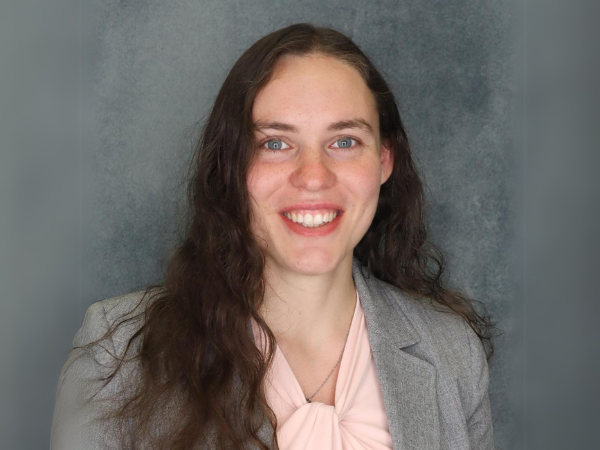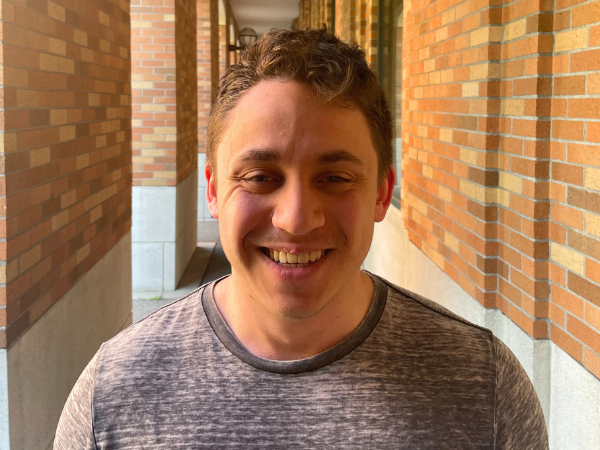Amy Sprague
June 6, 2025
"The quality of all the graduate student presentations was exceptional," said Professor Jim Hermanson, who hosted the event. "I was grateful not to be making the difficult decisions about award winners – frankly, all of the work we saw today was worthy of recognition."
Graduate students showcased cutting-edge research spanning the full breadth of aerospace engineering at this year's Showcase of Aerospace Research and Capstones (SHARC). From lightning strike simulators and satellite constellation robustness to patient-specific cardiac simulations and next-generation rocket engines, the presentations demonstrated the department's commitment to tackling challenges across space, air, and beyond.
Among the standout presentations, Hannah Shipman earned dual recognition for her groundbreaking work on rotating detonation engines, while projects from the CTRL Lab claimed two additional awards for their advances in autonomous vehicle safety and multi-agent interactions.
Thank you also to our judges: Abigale Snortland and Professors Martin Nisser and Avin Vijay.

Scenes from the 2025 SHARC Showcase.
Showcase winners
Award for Fundamental Discovery and the People's Choice Award: Hannah Shipman

Acoustic Analysis in Small-Scale RDEs
Master’s student Hannah Shipman earned both the Fundamental Discovery award and the People's Choice recognition for her research on "Acoustic Analysis on Small-Scale Rotating Detonation Engines." Working with Professor Carl Knowlen in the Rotating Detonation Engines Lab, Shipman is investigating a revolutionary type of rocket engine that could be up to 10% more efficient than conventional systems.
Rotating Detonation Engines (RDEs) work by creating continuous detonation waves that spin around a combustion chamber, potentially extracting more energy from the same amount of fuel than traditional rocket engines. These detonation waves both compress the fuel before combustion and create a pressure drop at the combustor exit, eliminating the need for conventional additions such as turbines and converging-diverging nozzles. The challenge is that these engines operate in an extremely complex acoustic environment, with sound frequencies in the kilohertz range combined with the physics of shock waves and detonations.
Shipman's work involves both theoretical modeling and experimental testing of different sizes of small-scale RDEs – from 10 to 25 millimeters in diameter – to understand how acoustic modes like radial, tangential, and transverse pressure waves affect engine performance. By developing a MATLAB code that integrates theory with experimental data, she's creating tools that could inform the design optimization of these next-generation engines.
The potential impact is significant: RDEs could enable simpler, more efficient propulsion systems for everything from airplanes and terrestrial power generation to spacecraft applications, offering better performance and efficiency in compact and simple designs.
Award for Applied Innovation: Kazuki Mizuta

Towards Safe and Predictable Social Navigation for Autonomous Ground Vehicles
Ph.D. student Kazuki Mizuta received recognition for his work on "Towards Safe and Predictable Social Navigation for Autonomous Ground Vehicles," a project that addresses one of the most critical challenges in autonomous systems: how to navigate safely around people in real-world environments.
Working with Professor Karen Leung in the CTRL Lab, Mizuta developed a unified framework that combines two powerful computational approaches. His system uses a reward-guided conditional flow matching model paired with model predictive path integral control, creating a bidirectional information exchange where each component informs and improves the other.
What makes this approach particularly innovative is its ability to adapt to dynamic environments in real-time without requiring retraining. The system incorporates safety rewards using control barrier functions – mathematical tools that ensure the vehicle maintains safe distances – while balancing the need to reach its destination efficiently.
Testing across various scenarios including pedestrian environments, mixed obstacles, and dense crowd simulations, Mizuta's framework demonstrated superior performance in safety, goal-reaching, and smooth acceleration metrics. This research could be crucial for the deployment of autonomous delivery robots, wheelchairs, and other ground vehicles that must operate safely in human-populated environments.
Award for Scientific Communication: Isaac Remy

Learning responsibility allocations for multi-agent interactions: A differentiable optimization approach with control barrier functions
Ph.D. student Isaac Remy earned recognition for clearly presenting his complex research on "Who's Responsible? Disentangling Safety in Multi-Agent Interaction." Also working with Professor Karen Leung in the CTRL Lab, Remy is tackling a fundamental question: how do we understand and predict which agent should adjust their behavior when multiple autonomous systems interact?
Remy introduces the concept of "responsibility" – defined as an agent's willingness to deviate from their preferred actions to accommodate safe interactions with others. Using control barrier functions and machine learning, his system can learn from data how different agents typically allocate responsibility in various situations.
For example, in a scenario where an autonomous car and a delivery robot approach the same intersection, Remy's framework can determine which agent should yield based on learned patterns of safe interaction. A neural network predicts these responsibility allocations from the current states of all agents involved.
This research provides an interpretable and quantitative way to understand multi-agent safety decisions, which is crucial as we move toward environments with multiple autonomous systems operating simultaneously. The work has applications for everything from autonomous vehicle coordination to robot teams working in warehouses or disaster response scenarios.
Explore all of our graduate research posters
Development of a Lighting Strike Simulator with In-Situ Loading
Nimit Berry
Multiscale Analysis of Materials and Structures Lab
Decentralized Multiagent Trajectory Planning
Justin Chang
The RAIN Lab
QOCO: A Quadratic Objective Conic Optimizer with Custom Solver Generation
Govind Chari
Implosion and scaling studies of field-reversed configuration targets in a MagLIF liner in 1D
Jeffrey Contri
Numerical Simulation of Liquid Oxygen Droplet Combustion in Hydrogen in Microgravity
Ben Davis
Estimation-Aware Planning
Aditya Deole
The RAIN Lab
Angle of Attack Estimation for Cross-Flow Turbines
Joan Matutes
Stall Dynamics and Sensitivities on High-Lift CRM Model
Juanita Osorio Tovar
Patient-Specific CFD in the Left Atrium Atrial Fibrillation vs Sinus Rhythm
Saveer Yogita Sharda
Juan Carlos del Alamo Lab
Satellite Constellation Graph Robustness via Random Geometric Graph
Qishi "Jackson" Zhou
The RAIN Lab